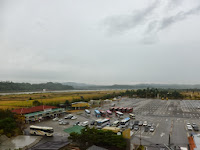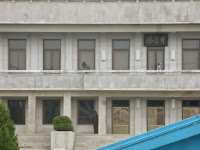The DMZ.
This is the 4 kilometer wide, land mine-filled, barbed wire fenced, Demilitarized Zone - the tense, uncomfortably quiet buffer zone between North and South Korea. What began with an uneasy armistice agreement in the 1950s has remained remarkably the same over the years. The crosshairs of two countries, torn apart by political divide and external rivalries, have remained ceaselessly pointed at one another across the quiet, deceptively tranquil countryside surrounding the DMZ.
While you wouldn't know it whilst shopping at the luxury boutiques of Gangnam, only 90 minutes away, South Korea is still technically at war with its northern enemy. That's right. The 1953 armistice agreement nominally ended the bloody conflict, but did not officially dissolve the conflict. A product of negotiations between the U.S, South Korea, North Korea, China, the DMZ was established as a buffer zone between the two states on the Korean peninsula.
60 years later, I found myself staring into the fringes of North Korea, in the United Nations Joint Security Area (JSA).
60 years later, I found myself staring into the fringes of North Korea, in the United Nations Joint Security Area (JSA).
The JSA, dually administered by the North and South (as well as a battalion from the United States), is the epicenter of activity within the DMZ. Concurrently referred to as 판문점 (Panmunjom), these were the little blue buildings I'd seen a dozen times on CNN.
Negotiations between North and South have intermittently taken place since 1953, inside these modestly furnished huts. As I stepped beside one of the conference tables, my tour guide informed me that I had just stepped into what is technically North Korean soil. Half of the conference room is devoted to the South, while the other half is given to the North. My curiosity burned as I peeked out of the foggy windows into what has to be the world's most secretive state.
After about ten minutes within the conference area, as the stone cold, statue-like guards stood watch, I stepped pensively and carefully back toward our entrance. As I looked back, across the divide, I saw one North Korean soldier, staring unshakably into our tour group with a pair of oversized binoculars.
Who is he? What's his name? What's his life like? What does he think about the world outside of the DMZ? These are questions I'll never know the answer to, but questions that rushed through me as I walked away from the JSA, each step taking me back into the 21st century, and back into the world that has seemed to turn the intentional blind eye to this decades-old relic of a long-forgotten war.












No comments:
Post a Comment